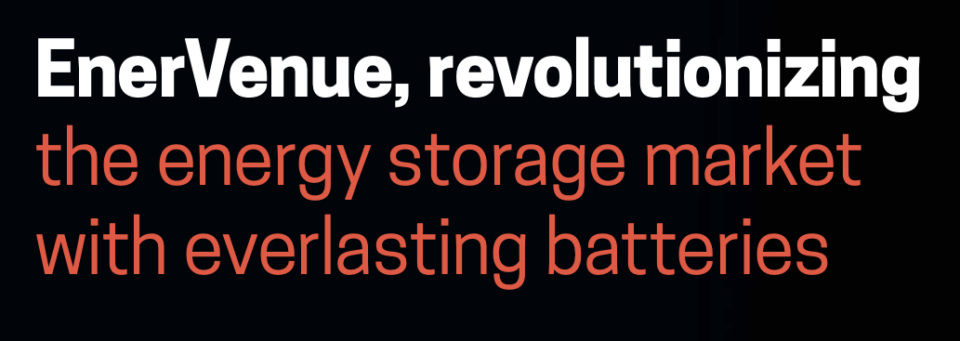EnerVenue is facing the challenge of scaling the production of its trademark battery to face demand. To do that it has the economic support of three strategic investors.
The energy storage market is changing profoundly, especially as the electrification of everything takes over the industry. And as renewables make a more significant part of the energy mix. For decades we have pluggin our devices into a wall for power coming from a station miles away and through steady transmission lines.
However, as renewables make up a bigger part of the mix, so does intermittency. Such intermittency obligates us to save power when it is available and cheaper — that’s when energy storage comes in handy. Still, energy storage devices need to step up to storing power efficiently, safely, and in a flexible manner. For example, at scale, some of the most common energy storage devices are pumped hydropower. Still, this technology has proven to be difficult to deploy as it needs dams and handmade water reservoirs that require lots of permits and infrastructure development.
Consequently, batteries became the most accessible and most sought energy storage medium. Lithium-ion batteries are the most common energy storage devices for both grid and home use cases. Nevertheless, lithium-ion poses severe fire risks. Not to mention that they have a profound environmental footprint as they require many rare earth metals to be manufactured.


As a result, for years, energy companies have sought to develop durable, safe, and cost- effective batteries to solve all these problems, with not so much success. However, EnerVenue, a California-based company, has developed a unique device that will truly disrupt the energy storage market worldwide.
Related: VAALCO Energy Provides Update on Etame Field Reconfiguration and FSO Deployment
EnerVenue has developed a durable, safe, flexible, and maintenance-free battery that is affordable and the most effective way to store energy for home and grid use cases. This device is a nickel/ hydrogen battery that can operate in a -40 to +60C ambient temperature with a 30+ year lifespan and 30K+ full cycles without degradation or usage restrictions.
Indeed, it is almost an everlasting battery that, due to its components, poses no fire or thermal hazard. Additionally, it has not any toxic materials and is easily recyclable. EnerVenue’s CEO, Jorg Heinemann, sat with us on an exclusive interview to talk about the batteries. He said about the matter: “our battery is a vessel; within that is a stack of electrodes. As we charge the battery, we build up a small amount of hydrogen within that vessel; then, as we discharge, water absorbs hydrogen. It’s like a low-pressure hydrogen fuel cell.”
The CEO remarked that the battery’s technology had been around for some time in the aerospace industry. “The nickel/hydrogen batteries were designed in the 1980s and then deployed in the ’90s and 2000s for aerospace applications.
Specifically for satellites, the International Space Station… They designed at a time when satellites needed a battery that would have a crazy long lifetime. And could not be maintained because sending someone to replace a battery to outer space is tremendously expensive.”
Read more: AXPC CEO Statement on Domestic Production & National Security
“It would also have to withstand the rigors of outer space, meaning very low or very high temperatures. When renewable energy came in, many batteries came on board, and nickel/ hydrogen technology was simply ignored due to its cost. It was way too expensive,” Heinemann said. Nevertheless, around four years ago, he said, Yi Cui, a Professor of Materials Science and Engineering at Stanford University and one of the world’s top Material scientists, assembled a team to conduct research on how to bring those costs down.
That team managed to reassemble the batteries for outer space with lower-cost materials without any performance shortcomings. “In fact, what we discovered in 2020 was that the battery performed better for this use case with the new materials,” the CEO commented.
The result was a battery that can almost run for a lifetime, without the risks of common lithium- ion. Due to its design,we can recycled the battery and repurposed very easily, delivering a “cradle to cradle product, the sustainability experts would say,” the CEO said. Moreover, the company has assembled several thousands of these devices up to this point. According to the executive, the next challenge is to bring up production to meet demand. For that, the company recently secured $100 million from Schlumberger and Saudi Aramco’s Energy Ventures and Towngas to expand its manufacturing capabilities. The investment came around a year after EnerVenue raised $12 million.
Read more: Laredo Oil Granted Drilling Permit for Lustre Oil Field Property in Northeast Montana
According to the executive, the company will use the funds to scale its nickel-hydrogen battery production, particularly through a Gigafactory in the U.S. and through an international distribution agreement with Schlumberger.
He commented about the matter. “After all of this, during 2022, we are doing our first megawatt-hour scale deployment. We have 10 MWh worth of batteries that we can produce in 2022. We will be deploying those with key customers at demonstration sites during this year.”
“The following year, we will bring online our full speed manufacturing line. In fact, we expect our first large-scale factory to be at full production, about 10 gigawatt- hours of production per year. That will be purely manufactured in the U.S. Some of our strategic investors will also help us to scale that capacity internationally, which will happen around 2024 and beyond.”
Consequently, the main challenge for the company ahead is how to scale up the production of these batteries, to put out not hundreds but millions of these devices out there in the market. The investment from Schlumberger, Saudi Aramco, and Towngas is also relevant as the three companies worked in oil and gas. But are now transitioning and helping their clients transition into new energies. Consequently, investing in EnerVenue will help them accelerate that transition.
Read more: VAALCO Energy, Inc. Announces Fourth Quarter and Full Year 2021 Results and Provides 2022 Guidance
“Our three strategic investors are very interested in our technology because they are looking to capitalize on the energy transition, and they recognized that their core business (oil and gas) is now pivoting to power. So, they have looked at our technology, and they liked our unique capabilities: flexibility, durability, safety.
They view it as critical for their energy transition to convert their existing oil and gas customers to new energies.”
The interesting thing is that each of those three strategic investors of EnerVenue could consume the 100% planned output of the company for the next five years. Consequently, the scaling of production is a big element of EnerVenue’s strategy for the future.
As a conclusion, Jorg Heinemann said. “The energy storage market is very interesting. As of 2018, everyone was waiting for a market to appear. Back then, everyone was asking when energy storage would become economically viable.
We are now at a point where energy storage is viable for some use cases. But with renewable energies going into the grid, the electrification of everything on the other end, and a lot of power purchases, we will need a lot of batteries that behave as our cellphones do. When we have excess power, we would want to charge our batteries quickly and discharge those fast or slow, depending on our needs. That means that our batteries would need to withstand multiple cycles and don’t wear out; to last almost forever. Our batteries would need to be easy to use, install, and recycle. That’s what EnerVenue will deliver, the battery that the industry will need in the near future.”


